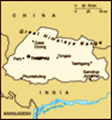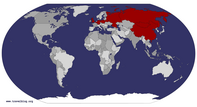Advertisement
Published: December 16th 2005
Exceedingly early morning, considering I am on holiday: up at 05:00. Once at the airport, I am faced with the usual mind-boggling burocracy, get papers from left, go to right and get a stamp, pay in centre, bring luggage at front for security check, get another stamp, go and get tag on baggage at front left, bring luggage at rear where my paper is taken, etc..
Of course, the paper for the visa for Bhutan is not waiting for me as was planned. This means we need to call the agency in Bhutan to get the number; bad luck, both the people in charge of it are in Bangkok and unreachable. After much phoning and begging, the under secretary for tourism confirms that they are waiting for me.
I am allowed to board the plane.
Because of the inefficient service displayed earlier by Druk-Air, I have been able to negotiate an upgrade to Business Class on both legs of the journey: Kathmandu - New Delhi and New Delhi - Paro. The plane is a surprisingly large Airbus 319.
Rarely have I seen such large seats and luxury in business class: the seats recline into fully flat beds,
a small bar has been installed in a corner, there are flowers everywhere, a terribly smart affair. I am mightily impressed with Druk-Air’s planes and on-board service. It is only when we arrive in Delhi that I understand why the business class is such a small heaven of luxury. The plane taxies to a special area in front of the VIP terminal and a huge security operation swings into place. The plane is surrounded by the Army; at first I think they are after my leatherman but it turns out that H.M the King of Bhutan is to join us from Delhi to Bhutan. The cabin has been arranged for his rather than my comfort.
The next hour and a half is spent searching the plane, being sniffed by a number of dogs with whom I am not allowed to play, having all my bags thoroughly searched, being asked to stand outside and witness the destruction of my carefully packed rucksack on the tarmac, etc…
Then, the Bhutanese security arrives. At first, I am intrigued by their national costume. It was introduced during the 17th century by Shabdrung Ngawang Namgyel to give the Bhutanese a unique identity. I
can assure that you that it is unique: it looks very 17th century. The dress for men is called a gho, it is a long robe hoisted to the knee and held in place with a kera, a woven cloth belt, wound tightly around the waist. The end result looks like a skirt barely reaching the knees. To cover their lower legs they wear knee-high black socks with black shoes.
Somehow, they remind me of the old European aristocracy with tights. They all wear large scarves draped around their right arm as a symbol of position, different colours for different offices. The Bhutanese people have to wear it every day and wear their scarves when going to work, temple or official ceremonies. I find it terribly smart and colourful.
I am politely required to change seats and retire to the back of the business class section. The red carpet is unrolled, the Bhutanese guards stand in line by the carpet, the Indian band starts playing, the stewardess get nervous and giggle furiously, the doors open and a crowd comes out.
Admist the crowd is the king, recognisable by his yellow scarf surrounded by the blue scarves of
the security. They approach the aircraft, bid fond farewells to the local dignitaries, and step into the plane. The man himself is there, His Majesty the 4th King of Bhutan. He sits down on the first row, the rest of his delegation spreads into the cabin. The only seat left empty is next to mine: I ought to have showered in the morning, one chap considered sitting next to me but thought better of it. I am the only foreigner in the plane, it seems that all the others are Bhutanse as they are all dressed in their gho. We are served a delicious lunch, which I eat with enthusiasm. After lunch, I am served a cup of tea and admire the tip of the Everest to our left when H.M the King comes and sits next to me. He speaks terribly good English and insists on welcoming me personally to his country. I am most touched. We converse about our lives. He is interested to know what draws me to Bhutan, about my trip so far, what I do in the UK. He was partly educated in the UK, so we swap school stories. He is a very kind
gentleman with an engaging smile and a simple welcoming character. He is clearly very proud of his country.
The arrival in Paro is an experience I am unlikely to forget for a long time. The country is uniformely mountainous and has no or little flat terrain. The little there is, is (or rather, was) in Paro: it is now the International airport (not that there are any other airports). It is said (according to my guide book) that the longest straight road in Bhutan is indeed the runway. Access to the runway is made by zigzagging through the valleys. H.M warned me that I would see the mountains closer than I ever had before. He was right: we skimmed over trees and rocks on either side of us. At a number of occassions, I thought the tip of the wings was going to go through someone's window or cut the power lines. The plane landed using the entire length of the runway and practically makes a three point turn to taxi back on the runway to the terminal. The entire cabinet, the four wives, the buddhist hierarchy and countless servants and well-whishers are there to welcome back H.M the
King, he bids me luck and attends to his duties.
Bhutan has been described by the Earl of Ronaldshay in his book "Lands of the Thunderbolt" in this manner:
“With our passage through the bridge, behold a curious transformation. For just as Alice, when she walked through the looking-glass, found herself in a new and whimsical world, so we, when we crossed the Pa-chhu, found ourselves, as though caught up on some magic time machine fitted fantastically with a reverse, flung back across the centuries into the feudalism of a medieval age”
The look of the country is utterly different from its neighbours: the mountains are covered in vast pine woods, dotted with swiss style chalets sporting tibetan decorations, there are rivers flowing rapidly at the bottom of the valleys, winding roads dominated by the snow covered peaks of the Himalayas. It would take little imagination to think that I am in Switzerland, everything reminds me of it, even the numerous cows on the roads.
Bhutan is not an ordinary place: it seems to have one foot fermly anchored in the past and the other testing the temperature of the future, tentatively dipping in a big
toe.
H.M and the country as a whole are very concerned that allowing modernity to take over the country will destroy traditions and the ancestral way of life. Everything seems to be based around the holding of traditions: there is not a single house built in "modern" style. The houses are good looking, rectangular in plan and usually of two storeys, the lower one for lifestock, stables, grain reserves and tools, the higher one are the living quarters of the familly with a little temple. There is an open loggia below the roof, sadly not used for Pimms and coktails parties but rather drying crops or storing wood. All the houses have traditional wall paintings, somtimes worringly large penises, wood carvings and elevated roofs. Every house looks to be in a good state, they are well kept and maintained. Everyone wears the national costume at all times. There are few imports, all of them heavily regulated by the govt.
There is only one shop where one may buy a car and it is governement owned. The villages have a system where, in the centre, there is a wholesaler ran by the govt. and all the small shop buy
from the wholesaler to resell in smaller quantities. There are no supermarkets but a large week-end market with vegetables, chillies, meat and fish on offer.
There seems to be very little or no poverty, there are no beggars, the streets are clean, everyone seems to be in good health with clean clothes on. For the first time since I am in Asia, my arrival in a place draws no reaction, no beggars, no children come rushing to my side, not even a flicker of intrest form the local population. A welcome rest. The children all coming out of school in their colourful uniforms are well behaved and look like a procession of parrots.
My guide is a terribly kind chap. As to his name, I asked three times, he told me three times and I forgot three times. Thereafter, I called him Mr Nice. He insists on treating me like a prince and seems thoroughly dissapointed if I carry a bag or open myelf a car door.
We find ourselves in a very singular hotel, where the lights don't always work but the waiters wear white gloves to serve dinner. The hotel was built at the occassion
of the coronation of the present king to host foreign royalties and dignitaries. It is large, well appointed, comfortable and absolutely empty. I am given 7 keys and told to choose the suite I prefer. I take the suite which was prepared for the Nepali King. He has a large terrace, 2 sitting rooms, 2 bathrooms, a dining room, and countless other rooms whose purpose I have not yet defined. I am not quite sure what to do with all this space.
Advertisement
Tot: 0.147s; Tpl: 0.02s; cc: 9; qc: 56; dbt: 0.096s; 1; m:domysql w:travelblog (10.17.0.13); sld: 1;
; mem: 1.2mb





















grantcorp
Johan
Ha ha ha, great stuff!
Now I remember the paragraph somewhere in the LP guide to Bhutan; you should dress smart when in the cities because you are likely to run in to high government officials. I think you have just proved their point...